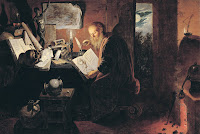
At the press luncheon for the chameleonic new “Alchemy” show, Bruce Museum public relations director Mike Horyczun conducted an experiment in which he used a tea-colored liquid— actually red-cabbage juice —to transform four glasses filled, it seemed, with water into different colors. (Turns out the glasses contained varying levels of acidity, hence the jewel-like colors.)
“He’s a witch!” one of the luncheon guests yelled out in mock horror. “Burn him at the stake!”
Well, yes, such was the attitude toward alchemists in previous times that even the great Isaac Newton, a passionate alchemist, had to tread carefully. In our own enlightened era — OK, our somewhat more enlightened era — the Bruce can pose the titular question “Alchemy: Magic, Myth or Science?” without having to worry about torches and pitchforks.
Indeed, at various moments in history, alchemy — an ancient discipline that sought to explain how matter behaved — has been viewed as all three. Because early philosophers could not observe atomic structures that actually affect matter, they often viewed its transformation as something almost mystical. (Although the ancient Greek philosopher Democritus did prefigure the Atomic Age by theorizing that matter was composed of tiny particles.)
The exhibit’s roughly 100 paintings, prints, documents, scientific instruments and mineral specimens, handsomely offset by Anne von Stuelpnagel's forest-green design, include a vibrant red and blue-green mandala from 15th-century Tibet (below, right) that alludes to the four elements — fire, water, air and earth — then thought to make up matter. Since everyt hing consists of these, Plato reasoned, one kind of matter could be transformed into another.
hing consists of these, Plato reasoned, one kind of matter could be transformed into another.
It wasn’t long before medieval Europeans, armed with Arabic alchemical texts, were vainly seeking elixirs to heal the body or turn base metals into gold. No wonder alchemists garnered a reputation for being nut jobs — or worse. The exhibit teems with 17th-century Dutch paintings, including those like Thomas Wijck’s “The Alchemist and Death” that warned contemporaries what would happen when you danced with the devil, so to speak. (The presence of these Dutch treats is no doubt due to Bruce executive director Peter C. Sutton, an expert in northern Baroque art.)
But as it turns out there is nothing magical or macabre about turning grapes into wine, grain into beer or sand into glass. It’s good old-fashioned know-how based on observations of a natural world that will ultimately reveal itself. Or so said the 16th-century alchemist and physician Paracelsus. (We owe him so much.)
For those of us who are no Paracelsus — and the Arts Muse is speaking entirely about herself here — Bruce curator of science Carolyn Rebbert has assembled a variety of Persi an wine jars (at right below), pigments, porcelains and pestles to make the complex concrete.
an wine jars (at right below), pigments, porcelains and pestles to make the complex concrete.
Traditional museum-goers will savor these objets d’art. But the exhibit might have most appeal for families, who’ll enjoy its card and board games, touch screens and scent tests.
(There’s even an Alchemy-Chemistry Family Day on Oct. 18.)
Such offerings bring the sciences down-to-earth — something for which scientists and nonscientists alike are no doubt equally grateful.
“Alchemy: Magic, Myth or Science?” is at the Bruce Museum in Greenwich through Jan. 3. Upcoming shows will consider the cartoons of Charles Addams and the prints of Alexander Calder. For more, log on to brucemuseum.org or call 203-869-0376.
And don’t forget that the Bruce is part of the Fairfield/Westchester Museum Alliance. That means admission to the Bruce, the Hudson River Museum in Yonkers, the Hudson Valley Center for Contemporary Art in Peekskill, the Katonah Museum of Art, Purchase College’s Neuberger Museum of Art or the Aldrich Contemporary Art Museum in Ridgefield, Conn. entitles you to free same-day admission to any of the others. (Members of one museum are admitted to the others for free and are entitled to a 10-percent discount at any of the gift shops.)
It’s a fair deal in troubled times.
Photos, including the image of David Rijckaert's "An Alchemist Studying at Night" (1648), which appears at top, are courtesy of the Bruce Museum.







